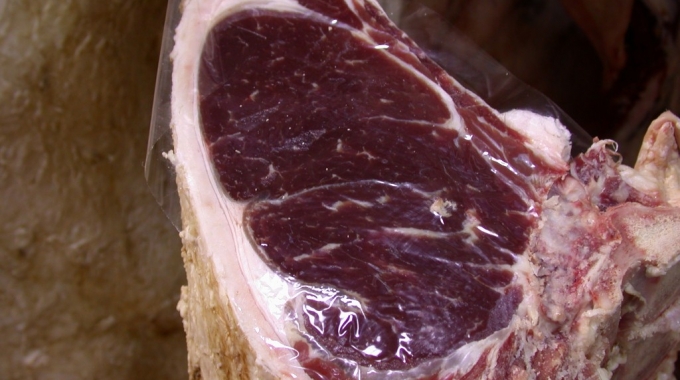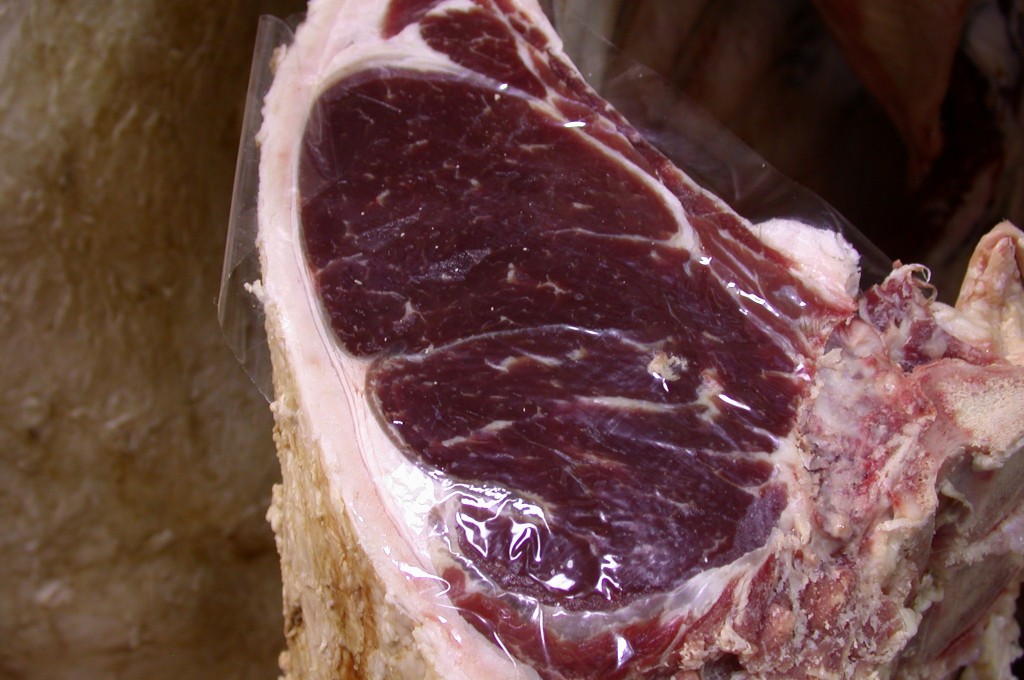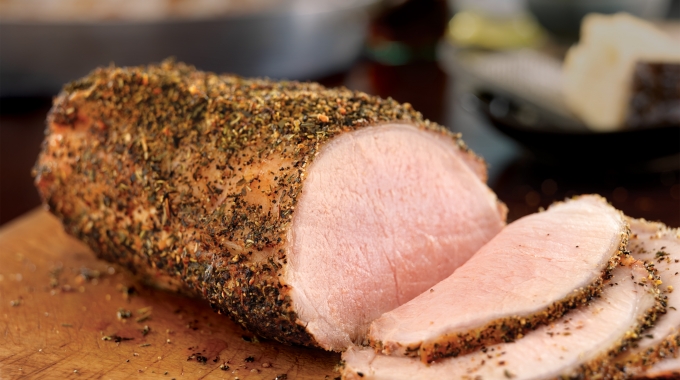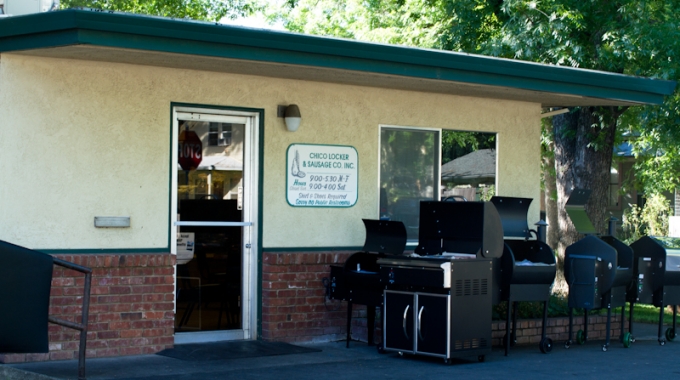
 It’s probably likely that if you solely buy meat from the grocery store, you didn’t know there was such as thing as purple meat. Yes, purple meat. Or as we call it in the meat industry, dark cutting beef. Dark cutting beef carcasses have a purplish-black color rather than a bright red color we are all used to. Often times, dark cutting beef may resemble meat that has been vacuum packaged, but vacuum packaged meat will brighten back up (or bloom) after the package has been opened and it has been exposed to oxygen. (see brown meat post for the science behind this). It is estimated that 1-2% of beef carcasses slaughtered end up dark cutting beef.
It’s probably likely that if you solely buy meat from the grocery store, you didn’t know there was such as thing as purple meat. Yes, purple meat. Or as we call it in the meat industry, dark cutting beef. Dark cutting beef carcasses have a purplish-black color rather than a bright red color we are all used to. Often times, dark cutting beef may resemble meat that has been vacuum packaged, but vacuum packaged meat will brighten back up (or bloom) after the package has been opened and it has been exposed to oxygen. (see brown meat post for the science behind this). It is estimated that 1-2% of beef carcasses slaughtered end up dark cutting beef.
But how does this happen?
In the time between slaughter and chilling the carcass, a chemical reaction known as glycolysis occurs in the muscle tissue. This reaction converts glycogen (basically the carbohydrates in the muscle) into lactic acid. This lactic acid causes the pH of the meat to decline from the neutral value of somewhere around 7.2 found in the live animal. This drop in pH is what turns meat red. Good quality beef has a final pH value of close to 5.5. As the pH value of the beef rises above 5.8, both tenderness and shelf life of the meat is adversely affected. Dark cutting beef is beef that has a pH level of 6.0 and higher. Besides being unappealing in appearance, dark cutting beef also tends to have the following characteristics:
- dry texture due to a high water holding capacity
- reduced shelf life due to higher pH and more moisture bacteria can grow more rapidly
- a sticky texture
 Dark cutting beef is triggered by high stress in an animal before slaughter. An adrenaline release or strenuous muscle activity before processing means that the supply of glycogen will be depleted, the chemical reaction will not occur, and the meat will remain dark instead of turning red. Stress could be from a variety of factors anything from transportation of the animals, mishandling, mixing of unfamiliar cattle, and even changing weather conditions.
Dark cutting beef is triggered by high stress in an animal before slaughter. An adrenaline release or strenuous muscle activity before processing means that the supply of glycogen will be depleted, the chemical reaction will not occur, and the meat will remain dark instead of turning red. Stress could be from a variety of factors anything from transportation of the animals, mishandling, mixing of unfamiliar cattle, and even changing weather conditions.
Dark cutting beef is not something new, feedlots and packing plants have known these factors for many years and take great care to avoid dark cutters. It’s one of the reasons why I never understand animal rights organizations try to make the argument that all animals are stressed out in slaughterhouses. If this were the case, the instance of dark cutters would be off the charts and the packing plants would be bleeding money. It is estimated by the National Beef Quality Audit that dark cutters cost the beef industry $5.00 for every animal slaughtered. $5.00 doesn’t seem like much but when you think about the fact that in 2012, USDA reported 33 million head of cattle being slaughtered with 98.4 percent of that total being done under federal inspection. That’s quite a bit of money being lost annually due to dark cutters. It has been estimated that Cargill alone loses a whopping $300 million dollars annually due to dark cutters. The meat from dark cutting beef is usually sold for a minimum of 10% less than it’s normal retail value because it is considered unappealing to the retail market. Customers want to purchase red meat, not purple meat.
How can we avoid dark cutting beef?
Professionals in animal handling like Temple Grandin have worked very closely with operations of all sizes, helping packing houses and slaughterhouses minimize and hopefully eliminate stress for the animals. Temple Grandin has outlined several steps for loading and unloading, restaining, and even how to deal with an excitable animal. Many of these methods are not only used in slaughterhouses, but are also used in feedlots and by individual ranchers working cattle too.
- Solid sides or barriers around the cattle to prevent them from seeing people deep inside their flight zones. This is especially important for wild or excitable cattle
- To prevent lunging at the headgate, the bovine’s view of an escape pathway must be blocked until it is fully restrained.
- Provide non-slip flooring for all species of animals.
- Slow steady motion of a restraint device is calming, while sudden jerky motion excite.
- The entrance of the restraint device must be well lighted, however, lamps must not glare into the eyes of approaching animals. All species must be able to see a place to go.
- Livestock will remain calmer if they can see other animals within touching distance.
- Engineer equipment to minimize noise. High pitched noise is more disturbing to livestock than a low pitched rumble.
It is fairly easy to spot cattle that are stressed, often times this is due to fear or uncertainty. Signs of stress in cattle are typically vocalization (lots of moo-ing or bellowing), eyes wide open with head high, panting, lots of defecating. Slaughterhouses as well as feedlots and other operations carefully monitor animals for this kind of behaviour and do their best to prevent it from happening.
So what happens to dark cutting beef?
Appearance is dark cutting beef’s number one repellant when it comes to the retail market. Since retailers won’t purchase dark cutting beef due to the fact that it won’t sell, most of dark cutting beef ends up in the food service industry side in places where customers don’t see the raw product but instead enjoy the cooked product. Although dark cutters can cause meat to become dry and sticky and sometimes tough, there is really no palatability problem with dark cutting beef. And it certainly makes perfectly fine hamburger!
Professionals in the meat science industry have been working towards enhancing and further utilizing dark cutting beef to essentially improve the value. One of the problems in dark cutters when it comes to whole muscle cuts is that even after it’s been cooked, dark cutting beef still retains its dark color. Almost as if the meat hadn’t been cooked at all. This is a huge turnoff for retail as well as food service professionals. Dr. Jason Apple from the University of Arkansas found that through trials done on dark cutting beef enhanced with lactic acid (0.25-1% lactic acid), they could change pH which results in a dark cutting beef becoming nearly impossible to tell the difference between a beef grading somewhere around low choice both in fresh and cooked beef. If you are interested in the specifics, the video below is pretty neat.
The process of dark cutting beef occurs can happen in other species of animals like sheep and pork, it’s not strictly limited to beef. The chemical process is just a little different in other species, but the end result is the same. It’s a lose-lose for everyone when you have a dark cutting animals come through the packing plant. By understanding animal behavior and pairing that with proper animal handling techniques, slaughterhouses can avoid purple meat and we all can enjoy that bright red meat we all know and love.
For more information on dark cutting beef, visit these resources:
- Dark, Firm, and Dry Beef
- Dark Cutting Beef
- Dark Cutting Beef from Texas A&M
- Dark Cutting Beef- What Is It?





well that was an interesting read!! Working in the beef industry, I know about dark cutters, but I didn’t know that it was edible meat!